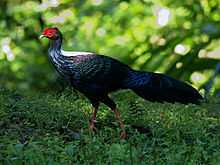Swinhoe's pheasant
| Swinhoe's pheasant | |
|---|---|
 | |
| Conservation status | |
| Scientific classification | |
| Kingdom: | Animalia |
| Phylum: | Chordata |
| Class: | Aves |
| Order: | Galliformes |
| Family: | Phasianidae |
| Subfamily: | Phasianinae |
| Genus: | Lophura |
| Species: | L. swinhoii |
| Binomial name | |
| Lophura swinhoii (Gould, 1863) | |
Swinhoe's pheasant (Lophura swinhoii) is a bird of the pheasant subfamily in the fowl family Phasianidae. It is endemic to Taiwan.
Description
The male has a glossy blue-purple chest, belly and rump, white nape, red wattles, white tail feathers, and a white crest. The female is brown marked with yellow spots and complex barring patterns, and has maroon outer rectrices.
During display, the male's wattles become engorged and he performs a display consisting of a hop followed by running in a circle around females.
Habitat
The bird is limited to the mountains of central Taiwan, where it lives in forest habitat up to 2,300 meters in elevation.[1]
Swinhoe's pheasant eats seeds, fruits, and some insects and other animal matter.
The female lays a clutch of 2 to 6 eggs which are incubated for 25 to 28 days. The young can leave the nest at 2 to 3 days old.
Conservation
This pheasant has a small population in a limited range which is shrinking due to habitat degradation. Logging is a problem. Some populations are secure within protected areas, but others may be declining. It was hunted in the past and some populations were extirpated in the 1960s and 1970s. Today its global population is estimated to be over 10,000 individuals.[1]
Etymology
The bird was named after the British naturalist Robert Swinhoe, who first described the species in 1862.
See also
| Wikimedia Commons has media related to Lophura swinhoii. |
References
- ↑ 1.0 1.1 1.2 BirdLife International (2012). "Lophura swinhoii". IUCN Red List of Threatened Species. Version 2013.2. International Union for Conservation of Nature. Retrieved 26 November 2013.
